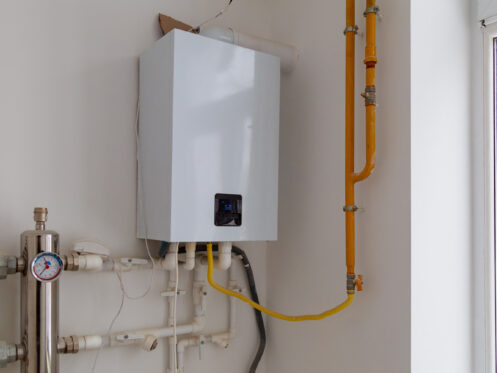Hello, this is Matt from Service Inbound! I’m here with Klint Sloan from 3 Mountains Home Services: he’s a technician, and he’s going to tell us a little bit about tankless water heating and why homeowners should consider it as an alternative to conventional water heating. How are you doing, Klint?
I’m good!
Great! So, what we want to talk about is how tankless water heating works and what it can do for a homeowner — but first, tell me about 3 Mountains Home Services.
We’ve been doing service work for the past 5, 6 years. It’s a great company to work for, and it’s a great company to have work done by. We have great warranties, we take care of our customers, and we put homeowners first.
Excellent, excellent. So if I’m a homeowner and I’m looking to install water — whether I’m remodeling my basement or for some other reason need a replacement — why should I choose tankless over conventional?
Tankless are much for efficient as far as the use of gas for heating the water. You will have a continual flow of hot water, you will never run out of hot water, and with the units nowadays the flows are just as good as having a conventional tanked unit. The energy consumption is probably the best benefit of them: they use a lot less energy, so the utility bill for heating your water is much less.
So when you talk about efficiency, does that mean I would save money if I decide to go with the tankless?
You would save money in the long run on your utility bills. Tankless is a bit more expensive to install and procure the heater itself — the product itself is more expensive. But in the long run, they last longer than a regular tanked unit and pay for themselves from energy bills.
How long do the tankless water heaters last?
They usually last about 15 to 20 years, if not longer, with proper maintenance.
And comparison to conventional: how long do the tanked water heaters last?
The industry average for a tanked water heater, gas or electric, is about 8 to 13 years.
What does the warranty look like on a tankless water heater?
The tankless we install are the Noritz brand, and we put a ten-year all-inclusive warranty which covers all parts and all labor for ten years. It also includes maintenance every two years.
So, you prefer Noritz; are there any particular reasons that you prefer that brand?
We have researched many different models and have installed many different models, and I have found that the heat exchanger, which is the main component of any tankless water heater, is made of a higher grade copper so it will last longer and won’t have as many issues. We’ve found that the electrical components in the Noritz tend to have fewer issues also. Overall, we’ve just found that they’re a much longer-lasting unit than other brands.
Right. So, tell me about the installation process for tankless.
Well, first, a few different things: we highly recommend that people do not use electric tankless water heaters because the electricity will reduce the water flow to heat the water and they use a lot more electricity than the conventional water heater. The way that I compare is that for a tankless water heater on electric, you’d have to have as much power as three conventional water heaters; most people don’t have that much on their panel. And they don’t work as well, either. That’s why we recommend the gas type to all of our customers.
Secondly, on the gas units that we put in, one of the other things that some people don’t understand about tankless is this: they will use less gas overall, but when they do fire up they use more gas at the time because they are heating it on demand. This means that usually we also need to upgrade the gas line to make sure it has enough flow. A conventional water heater has between 40 and 50 thousand BTUs (a British Thermal Unit, which is a way of measuring how much energy something uses); a tankless one will use 199 thousand BTUs, but only when you demand water. The conventional tanked unit will be heating the water continually throughout the day.
And finally, tankless units have specialized venting, so you can’t just hook them up to a regular aluminum B vent or normal atmospheric venting. We normally do PVC piping to a termination point either on the side of the house or through the roof to draw air from and exhaust from the outside.
On that topic: what exactly do you need for a tankless to work? What size gas line, etc.?
It depends on how far away you are from the gas meter. Usually, when houses are plumbed for gas, the piping is big enough to service what they have installed — usually, a water heater, a furnace, a gas fireplace, a BBQ — but when you add on the extra BTUs of a tankless, the gas line often isn’t big enough, so you have to run one inch or a 3/4 inch line instead of the half inch most homes are equipped with now. However, that all depends on where you’re having it installed.
So, one problem that homeowners have reported with tankless water heating has been inconsistency: sometimes owners have reported cold showers. Is that an issue that the newer models have done anything to change or address?
Yes, it has! With the Nortiz, we’ve found that you rarely if ever get a cold shower. Usually, that only happens on a unit where somebody has not done the proper maintenance, where it stops firing properly because the components have stopped registering what needs to happen. That’s what happens with the cold water-type scenario. In the past, people would get what is called a “cold water sandwich” effect in the line, which is when your hot water takes a moment to heat up, just at the beginning of the shower. It’ll send some hot water through the line, then you’ll get some cold water, then hot water again. That still happens occasionally with all water heaters, but not very often anymore with the newer Noritz technology.
How do I maintain my tankless water heater?
What we do is that we eliminate build-up. The insides of a tankless water heater are copper, and over time you get hard water or limescale That’s why all the units that we install have an isolation kit that’s on the bottom where it connects: what it does that it isolates the water by itself as we run a solution that clears out all the buildup and limescale. We let that run for about to hour to pump all of that out, and then we flush the unit, test it again, and that cleans out all of the filters and pipes. So it’s heating just like when it was brand new.
Does 3 Mountains Home Services offer a specific maintenance program?
Included with our installation warranties is maintenance every two years. We recommend that the maintenance be done every two years even after the warranty is up; if it’s a tankless we installed, you get a lower rate. Still, we do maintenance on any water heater at all.
Great. So am I missing anything here? Is there anything you’d like to add before we close?
The thing I want to add is this: a lot of people would like to have a tankless because of the savings and the green factor of a tankless water heater without realizing that the cost itself of installation is usually higher than that of a standard water heater. However, over time you’re going to save money because it’s going to last longer and you’ll pay less on your utility bills, so it’s an investment rather than a short-term fix. When you keep that in mind, it’s a great investment to make.
Thanks so much for your time, Klint.
No problem.
Before we go, how can customers learn more?
You can go to noritz.com as a great resource for finding out how tankless water heaters operate and how much they cost, and you can also visit our website, 3mountainsplumbing.com, to download our e-book buyers guide.
Excellent! Thanks again, Klint, and thanks everyone for listening. This has been Matt with Service Inbound and Klint of 3 Mountains Home Services. Call 3 Mountains Home Services about tankless water heaters today!


